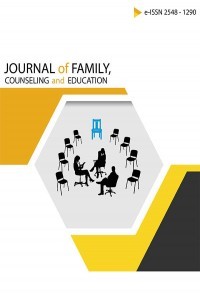Investigation of High School Students' Peer Bullying Levels in Terms of Various Variables
Investigation of High School Students' Peer Bullying Levels in Terms of Various Variables
Peer bullying, High school scale, students,
___
- Arslan, N. (2017). Peer bullying among high school students: Turkish version of bullying scale. Turkish Online Journal of Educational Technology-TOJET. 853-857.
- Arslan, S., & Yeşilyurt, F. (2019). Ergenlerin sanal zorbalık düzeylerinin bazı değişkenler açısından incelenmesi. OPUS- Uluslararası Toplum Araştırmaları Dergisi, 11(18), 27-42. DOI: 10.26466/opus.515067.
- Atik, G., Özmen, O., & Kemer, G. (2012). Bullying and submissive behavior. Eğitim Bilimleri Fakultesi Dergisi, 45(1), 191.
- Ayas, T., & Pişkin, M. (2011). Investigation of bullying among high school students with regard to sex, grade level and school type. Elementary Education Online, 10(2), 550-568.
- Craig, W. M., Pepler, D. J., & Blais, J. (2007). Responding to bullying: What works? International Journal of School Psychology, 28, 15-24.
- Kapıkıran Acun, N., & Fiyakalı, C. (2003). Lise öğrencilerinde akran baskısı ve problem çözme. Pamukkale Üniversitesi Eğitim Fakültesi Dergisi, 18(18), 11-17.
- Karagöz, S., & Rüzgar, M. (2020). The observations of student teachers in regard to professional qualifications of advisor teachers during teaching practicum. International Journal of Educational Research Review, 5(2), 141-150. DOI: 10.24331/ijere.691323.
- Karagöz, S. (2016). Opinions and suggestions regarding various subjects on the educational guidance in the second constitutional era. Journal of Family, Counseling, and Education, 1(1), 1-9.
- Kaya, İ. (2020). Investigation of the relationship of physical and relational aggression of preschool children with temperament characteristics. Journal of the Human and Social Sciences Researches, 9(5), 3361-3378.
- Kaya, İ. (2020). The investigation of children’s persistent and reactive behavior with respect to parenting attitudes. International Journal of Progressive Education, 16(6), 273-282.
- O’Connell, P., Pepler, D., & Craig, W. (1999). Peer ınvolvement in bullying: Insights and challenges for ıntervention. Journal of Adolescence, 22, 437-452.
- Shaw, T., Dooley, J. J., Cross, D., Zubrick, S. R., & Waters, S. (2013). The Forms of bullying scale (FBS): Validity and reliability estimates for a measure of bullying victimization and perpetration in adolescence. Psychological assessment, 25(4), 1045.
- Totan, T., & Kabakçı, Ö. F. (2010). İlköğretim ikinci kademe öğrencilerinde sosyal duygusal öğrenme becerilerinin zorbalığı yordama gücü. Uludağ Üniversitesi Eğitim Fakültesi Dergisi, 23(2), 575-600.
- Ural, B., & Özteke, N. (2010). Okulda zorbalık. Ankara: Kök Yayıncılık.
- Üneri, Ö. S. (2011). Çocuklarda akran zorbalığı. Düşünen Adam, 24(4), 352-353.
- Yayın Aralığı: Yılda 2 Sayı
- Başlangıç: 2016
- Yayıncı: Eyüp ÇELİK
Stress Scale (Automatic Thinking): Investigating the Psychometric Properties
Sümeyra Dilek UYLAS, Nihan ARSLAN
Development of the Prescriptive Beliefs Regarding Divorce Scale: Validity and Reliability Study
Ayşegül SAYAN KARAHAN, İbrahim YILDIRIM
Investigation of High School Students' Peer Bullying Levels in Terms of Various Variables
Mustafa KOÇ, Tuncay AYAS, Fikret SOYER, Tuğba Seda ÇOLAK, Betül DÜŞÜNCELİ
